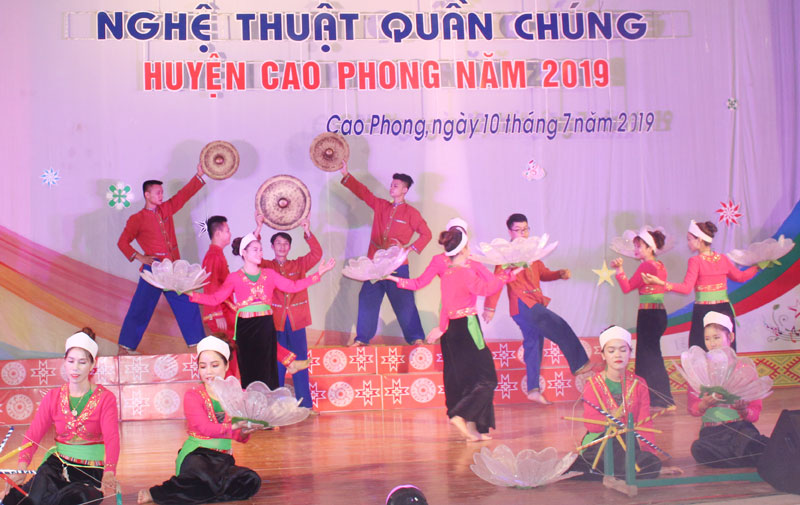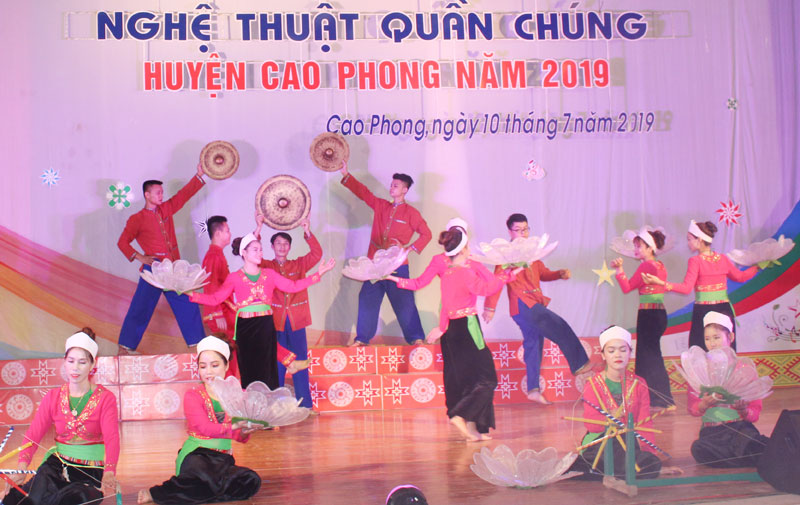
(HBO) - The festival of the public performance in Cao Phong district in 2019 has really become a festival of the actors, the artisans and the people of Cao Phong district. With over 60 featured songs, dances and music performed by the public performing arts teams, the festival has brought a rich colorful picture, introducing the special local culture and has left a lot of emotions for the viewers.
 The dancing performance "The beauty and flavor of Thang
Muong" by Bac Phong commune at the festival of the public performance in
Cao Phong district in 2019.
The dancing performance "The beauty and flavor of Thang
Muong" by Bac Phong commune at the festival of the public performance in
Cao Phong district in 2019.
Mr. Bui Van Hung, the Deputy Director of Cao Phong Center
for Culture, Sports and Information, says that this festival of the public
performance has been highly appreciated in terms of quality and quantity. The
mass cultural movement in the district has been maintained and increasingly
developed, spreading and attracting a large number of people to participate.
The quality of the movement has also been improved. The content of activities
of the performing arts teams at the grassroots is folk songs, folk dance,
traditional musical instruments, traditional costumes and so on. This is a
factor contributing to preserving the traditional beauty and the cultural
identity of the nation.
Currently, 100% of the villages, the hamlets and the
residential areas have performing arts teams, each team has from 20 to 30
members. Every year, besides the competitions and the performances of the
public performance, the propaganda are held periodically and the localities,
the agencies, schools also organize many competitions, performances, festivals
of arts performances associated with the great holidays, the great local events
of the localities and units with a wide variety of topics.
The members of the public performing arts teams are also
active propagandists in propagating the guidelines of the Party, the policies
and the laws of the State, contributing to the prevention and control of the
social evils and building a cultural life at the grassroots level.
The People’s Committee of Lac Son district held a ceremony on April 28 to receive the provincial relic certificate for the ancient rock carving site at Suoi Co stream, located in My Thanh commune.
A special music show titled "The country is in the fullness of joy” has been held at Hoa Binh Square in Hoa Binh city in celebration of the 50th anniversary of the liberation of the South and national reunification (April 30, 1975–2025).
The People's Committee of Lo Son commune, Tan Lac district, has organised the local annual traditional stream fishing festival on April 19 - 20.
As a land deeply intertwined with human history and Vietnam’s millennia-long journey of nation-building and defence, Hoa Binh is often revered for its epic tales and legends.
Residents of Hoa Binh boast a rich cultural identity, reflected in their unique language, traditional attire, customs, and folk melodies – described as "sweet as honey, clear as a mountain stream.”
Lac Son district’s Vu ban town held the 2025 Truong Kha temple festival on April 12–13 (the 15th–16th days of the third lunar month). Since its revival in 2019, the festival has been organised every three years, preserving valuable intangible heritage while meeting the community’s cultural and spiritual needs.



 The dancing performance "The beauty and flavor of Thang
Muong" by Bac Phong commune at the festival of the public performance in
Cao Phong district in 2019.
The dancing performance "The beauty and flavor of Thang
Muong" by Bac Phong commune at the festival of the public performance in
Cao Phong district in 2019.